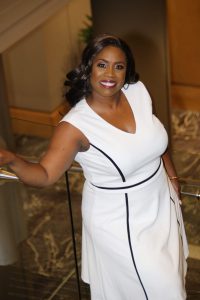 Lynita Mitchell-Blackwell is a Leadership Champion! She is an attorney, CPA, highly sought-after Transformational Speaker and Bestselling Author of three books on leadership and business development. Lynita is the CEO of both Leading Through Living Community, a book publishing and success coaching company, and BOLD Favor Media Group, a magazine publishing and event management firm. She serves as Chairperson of the National Board of Directors of the Leadership Innovation Transformation (LIT) College Tour, is a past president of the Georgia Chapter of the American Academy of Attorney-CPA’s, and is the recipient of several awards including the Lifetime Achievement Award by the US President’s Council on Service and Civic Participation. To learn more about Lynita, visit www.livingthelifestyle.live.
Lynita Mitchell-Blackwell is a Leadership Champion! She is an attorney, CPA, highly sought-after Transformational Speaker and Bestselling Author of three books on leadership and business development. Lynita is the CEO of both Leading Through Living Community, a book publishing and success coaching company, and BOLD Favor Media Group, a magazine publishing and event management firm. She serves as Chairperson of the National Board of Directors of the Leadership Innovation Transformation (LIT) College Tour, is a past president of the Georgia Chapter of the American Academy of Attorney-CPA’s, and is the recipient of several awards including the Lifetime Achievement Award by the US President’s Council on Service and Civic Participation. To learn more about Lynita, visit www.livingthelifestyle.live.
What does organizational culture mean to you?
When people come together, they create a new organism. Each person’s unique talents, abilities, and intelligence (intellectual, emotional, and spiritual) form an energy that creates its own rules and customs. These ways of doing things and getting things done is the organization’s culture. Each person contributes to the establishment of collective norms, both intentionally and subconsciously.
What are the major determinants of organizational culture?
The collective norms that form an organizational culture include every aspect and function of the people within it.
- Leadership as an expression of lifestyle
The person with the ultimate responsibility of the organization is its leader. Now, whether that person is both the one who has the recognized title and the actual authority to lead is a different matter. People within the organization determine who they will follow based on respect, admiration (even if there are heightened components of fear), and perceived power.
Leaders exude a certain level of confidence, which leads people to believe they are capable and knowledgeable. Even when jealousy, anxiety, and resentment are present, people will follow a person they perceive can get the job done.
However, people perform with excellence when leaders inspire them. A knowledgeable person with both confidence and capabilities will motivate their people to work harder, longer, and with more enthusiasm, even when the work itself is not all that inspiring.
Organizations create a leader who is a blend of the actual and recognized authority to guide them through. The extent as to whether the person “in charge” is also the person who holds the title will be determined by the people within the organization. This is because the culture of the organization is a blend of the people within it. If more people are fixated on results, they will select the person who gets things done. If more people are fixated on order, they will select the person with the title.
- Directional fluidity in the communication flow
How an organization communicates information is as important as how quickly it circulates throughout it. The cultural requirements for accuracy, transparency, completeness, and desired medium all impact the speed of information flow. Organizations that place more emphasis on accuracy will sacrifice speed to ensure the veracity of shared data. Organizations that value openness will insist upon completeness.
The people within these organizations demand information based on their perceived need for it. Those perceptions are created by the culture of the organization, influenced by the need to make decisions, project a sense of authority or power, and/or make their jobs easier.
- Prioritization of health and wellness
As society has embraced a more healthful mindset, organizations are reflecting that shift. Employees have signaled that health and wellness are a significant consideration in the work-life balance challenge.
An organization’s culture will determine how much time and attention is given to wellness-related activities and support, such as mental health days as acceptable use of paid time off (PTO), health clubs and gyms in the buildings where employees work, compressed and flexible work weeks to encourage more quality time with loved ones, and so on.
Organizations that reward “face time”, long hours, and less healthy pursuits (such as binge drinking and excessive travel) often see mental exhaustion, job dissatisfaction and high turnover as integral components to their cultures.
- Emphasis on financial health and bottom-line focus
Organizations function to be profitable in some way. Businesses do so for capital profits; non-profits and government organizations do so for the public good. Either way, the people within those organizations have a certain manner to measure performance dependent upon their culture.
Culture dictates whether an organization focuses on the dollar to the exclusion of all else; or if a cause or moral imperative can override the short-term decision to make profits to the detriment of others.
The way people are rewarded for decision making, business acumen, and financial gravitas is largely driven by culture. People want to be approved of and respected. The way people are rewarded is a key indicator of its culture – the qualities it holds most sacred in honor of its traditions and customs.
- Style and fashion as an expression of empowerment
The way people present themselves is a crucial component of organizational culture. It creates an unspoken agreement as to what is and is not acceptable, and therefore, who is and is not accepted.
Style of dress also brings into play the social ranking of people within the cultural hierarchy as well as how seriously a person is to be taken. Suits and briefcases in one organization may indicate respect and power, yet in another could indicate a sense of being out of touch and elitism.
- Community engagement and policy advocacy
How an organization relates to its key stakeholders is indicative of its culture. Some organizations are very involved, using community events as a way to stay engaged and get feedback from customers and clients. Other organizations take a more measured approach, staying out of the fray and only engaging when necessary. There are benefits and challenges to both approaches, and the culture of the organization will dictate which approach fits best with its objectives.
What is the role of employees in organizational culture?
Employees determine organizational culture. It is the combined essence of the people who work for the organization that creates and perpetuate the environment.
As employees are cultural creators, there comes a responsibility to ensuring it is a strong, supportive environment for those who work in it. “Strong and supportive” will be determined by the nature of the work involved and the leadership style of the organization’s management team.
What are the common problems associated with managing organizational culture?
Because there are so many people involved to create the “melting pot” that becomes the culture of the environment, and the fact that people are reluctant to change and wary of being the scapegoat during the “blame game” – even when they know something is not operating as it was intended – change is difficult.
When change is difficult, recruiting people with diverse mindsets, skill sets, and backgrounds can be a challenge. This directly impacts an organization’s ability to remain competitive in the marketplace and as a desirable place to work for top talent.
The same can be true whether an organization is a start-up or established, the people members of the Baby Boomer or Millennial generations, or the technology cutting-edge or tried-and-true. When people get comfortable in their groups, they tend to be less willing to let outsiders in, and they do not necessarily want to try new ways of doing things.
What are the ways to innovate company culture? Any best practices to share.
One way to ensure an organization has an optimal culture is to encourage openness. This is a step beyond transparency, as it encompasses receptiveness to feedback. Allowing people to share their thoughts without fear of reprisal allows the organization to explore “gut checks” and make changes as necessary to benefit employee morale and health.
Another practice to innovate culture is to require regular check-ins with leadership. The leader of an organization is a direct representation of its culture. So their performance and wellness state are indicative as to what is going on within.
Challenge employees to take corrective action when they see something inconsistent with the organization’s goals and directives and provide cover for them when things don’t go totally right the first time.
